
The Exodus from the East: Demographic Decline and Rural Transformation in Germany
Introduction
The eastern regions of Germany, once the heartland of the former German Democratic Republic (GDR), are grappling with a severe demographic crisis. According to a recent study, the population of Saxony-Anhalt, a state in eastern Germany, is projected to decline by more than twelve percent by 2040. This raises the alarming prospect of villages and even entire rural areas disappearing from the map.
Demographic Challenges
The population decline in eastern Germany is not a new phenomenon. Since the reunification of Germany in 1990, the eastern regions have experienced a steady exodus of people towards the more prosperous west. The reasons for this exodus are complex, but they include economic disparities, a lack of employment opportunities, and a decline in social services.
The aging population and the low birthrate also contribute to the demographic crisis. In many eastern German regions, the proportion of elderly people is significantly higher than in the west. This puts a strain on healthcare systems and social services, further discouraging young people from staying in the area.
Consequences for Rural Areas
The demographic decline has a profound impact on rural areas in eastern Germany. As the population dwindles, so too do the services that they depend on, such as schools, hospitals, and public transportation. This makes it increasingly difficult for people to live in these regions, further fueling the exodus.
The Plight of Villages
The situation is particularly dire in small villages, which have been hardest hit by the population decline. In some cases, villages have become almost entirely depopulated, with only a handful of elderly residents remaining. These villages face an uncertain future, as they struggle to maintain even the most basic services.
The Resilience of Rural Communities
Despite the challenges, many rural communities in eastern Germany are showing remarkable resilience. They are adapting to the demographic decline by finding innovative ways to sustain themselves. For example, some villages have converted empty buildings into community centers or housing for refugees. Others have launched initiatives to attract new residents, such as offering subsidies for young families or creating coworking spaces for entrepreneurs.
Policy Responses
The German government is aware of the demographic crisis in eastern Germany and has taken steps to address it. These measures include financial support for businesses, infrastructure projects, and social services in rural areas. The government is also working to improve education and training opportunities for young people in the east.
The Future of Rural Eastern Germany
The future of rural eastern Germany is uncertain. The demographic decline is likely to continue, at least in the short term. However, there is also hope that rural communities can adapt and thrive by embracing innovation and collaboration.
Conclusion
The demographic decline in eastern Germany is a complex and multifaceted issue with far-reaching consequences. It requires a concerted effort from the government, businesses, and local communities to develop sustainable solutions that ensure the vitality and prosperity of rural areas. By investing in education, infrastructure, and community initiatives, Germany can help to preserve the unique character of its eastern regions and create a brighter future for its people.
